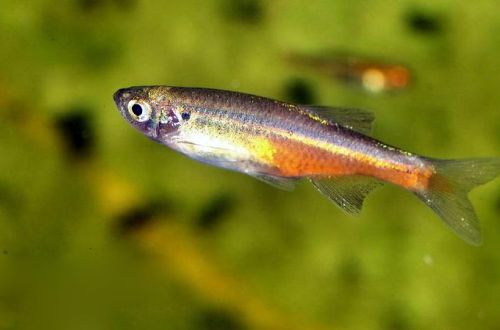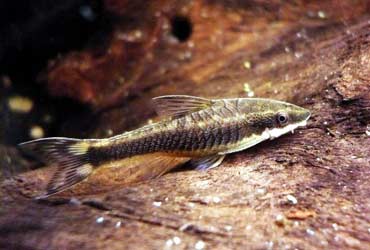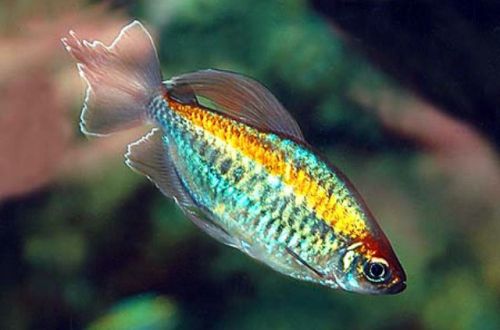
Danio-devario Sondhi
Danio-devario Sondhi, scientific name Devario sondhii, belongs to the family Cyprinidae (Cyprinidae). Available in the aquarium hobby since the early 2000s. Due to the similarity of color and body pattern with Microrasbora rubescens, confusion arose at first. Both species were often supplied under the same name. Considered easy to keep and breed. Compatible with other non-aggressive freshwater species capable of living in similar conditions.

Contents
Habitat
It comes from Southeast Asia from the territory of modern Myanmar, Shan State in the east of the country. Occurs in the basin of the Salween River (another name for Tanlain). The natural habitat is characterized by shallow streams and rivers flowing through hilly terrain. The water is clean, transparent with dense thickets of plants. Also, fish inhabit more muddy reservoirs, in particular rice fields.
Brief information:
- The volume of the aquarium – from 60 liters.
- Temperature – 20-26°C
- Value pH — 6.0–7.0
- Water hardness – 1–5 dGH
- Substrate type – any
- Lighting – subdued
- Brackish water – no
- Water movement – light or moderate
- The size of the fish is about 4 cm.
- Feeding – any food of suitable size
- Temperament – peaceful
- Keeping in a group of 8-10 individuals
Description
Adults reach a length of about 4 cm. The color is silver-orange, the fins are translucent. Barely noticeable blue and golden stripes stretch along the body. Sexual dimorphism is weakly expressed, males are practically indistinguishable from females.
Food
Not demanding on the composition of food. In a home aquarium, most popular foods are accepted with pleasure, such as dry flakes and granules, live or frozen bloodworms, daphnia, brine shrimp, etc.
Maintenance and care, arrangement of the aquarium
The optimal size of the aquarium for a small flock of 8-10 fish starts from 60-70 liters. The design is arbitrary, provided that there are dense thickets of plants, including floating ones, along with open areas for swimming. The lighting is subdued.
Keeping Danio-devario Sondhi will not require much effort. It is necessary to recreate habitat conditions suitable for this species of fish (temperature and hydrochemical indicators) and further maintain them. A filtration system and regular aquarium maintenance are key. The latter include weekly replacement of part of the water (30–50% of the volume) with fresh water, cleaning the soil and design elements from organic waste (excrement, leftover feed), and preventive maintenance of equipment. This is not a complete list of procedures, but it can be considered basic.
Important! The aquarium should be equipped with a lid to avoid accidental jumping out of the fish.
Behavior and Compatibility
A peaceful agile fish that pairs well with other Cyprinids and other species of comparable size and temperament. They prefer to be in a flock of 8-10 individuals. With less, behavior may change. Danios become “sluggish”, shy.
Breeding / breeding
Under favorable conditions, spawning can occur throughout the year. With the onset of the mating season, the fish scatter many eggs among plants and no longer show interest in future offspring. The incubation period lasts 24-36 hours, after a couple of days the fry begin to swim freely.
It should be noted that in the conditions of a common aquarium, the survival rate of juveniles will be minimal. They will have difficulty finding suitable food, and many will fall prey to other fish. Only a few will survive to adulthood.
If you plan to start breeding, you will need to prepare a separate tank – a spawning aquarium, which should always be ready. This is usually a small tank with a volume of about 20 liters, filled with water from the main aquarium to ensure identical water conditions. The set of equipment consists of a simple airlift filter and a heater. A separate light source is not required. The fry that have appeared are fed with specialized powdered feed, if possible, with brine shrimp nauplii.
Fish diseases
In a balanced aquarium ecosystem with species-specific conditions, diseases rarely occur. Often, diseases are caused by environmental degradation, contact with sick fish, and injuries. If this could not be avoided and the fish shows clear signs of illness, then medical treatment will be required. Read more about symptoms and treatments in the Aquarium Fish Diseases section.





